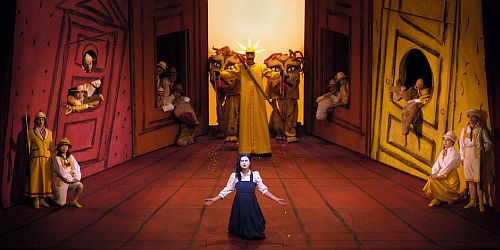 Germany Mozart, Die Zauberflöte (The Magic Flute): Soloists, Staatsopernchor, Sächsische Staatskapelle Dresden / Jonathan Darlington (conductor), Semperoper, Dresden, 23.5.2015. (MC)
Germany Mozart, Die Zauberflöte (The Magic Flute): Soloists, Staatsopernchor, Sächsische Staatskapelle Dresden / Jonathan Darlington (conductor), Semperoper, Dresden, 23.5.2015. (MC)

Cast:
Sarastro: Michael Eder
Tamino: Tomislav Muzek
Speaker: Matthias Henneberg
First priest: Julian Arsenault
Second priest: Gerald Hupach
Queen of the Night: Christina Poulitsi
Pamina: Carolina Ullrich
First woman: Roxana Incontrera
Second woman: Christian Bock
Third woman: Christa Mayer
Papageno: Sebastian Wartig
Papagena: Christiane Hossfeld
Monostatos: Timothy Oliver
Production:
Director, Set Design & Costumes: Achim Freyer
Scenery New Production: Hendrik Muller
Assistant Set designer & Costumes: Petra Weikert
Lighting: Gerd Budschigk
Chorus: Wolfram Tetzner
Dramaturgie: Hans Georg Wegner
With The Magic Flute Mozart collaborated with the versatile Bavarian impresario Emanuel Schikaneder who wrote the libretto. It’s a magical work with a popularity that has endured since it was first produced in 1791 at the Theatre auf der Wieden in Vienna; with Mozart conducting and Schikaneder playing the role of Papageno. Over the years there must have been numerous productions that didn’t serve Mozart’s opera as well as they might.
This revival of the production by director Achim Freyer at the Staatsoper Dresden is one such attempt that illustrates that no matter how absurd a director’s vision might be, it’s difficult to ruin this masterpiece. Nevertheless an errant director can make it an uncomfortable evening at the opera for all but the esoteric amongst the audience. I suspect the majority would prefer a more traditional take and will just put up with the staging for the performers’ sake if nothing else. Achim Freyer has turned The Magic Flute into a child-like fantasy world centring around the inside of an oversized crooked house in the manner of Alice and Wonderland and ridiculous costumes in primary colours such as the padded out telly-tubby outfits a number of the cast had to endure. It didn’t begin well as, prior to the overture with the curtain down, three children in telly-tubby outfits were pretending to play a most tiresome game with giant dice to decide Tamino’s fate but I wouldn’t have known this had I not previously read it in the programme. For some reason a vocal conductor was positioned in the orchestra pit sat on a high stool following a score. Another bothersome feature was the ladder from the pit to the stage that the odd cast member would hang on; I bet the orchestra loved that!
Croatian tenor Tomislav Muzek made an attractive young Prince Tamino. Barefooted Muzek was dressed in white shirt and black braces with baggy dark brown trousers and chalk white face. As demonstrated by his splendid early aria Zu Hilfe! Zu Hilfe! his vocal was bright, smooth and fluid with a noticeable vibrato but it never intruded. Heroine, Pamina, daughter of the Queen of the Night, was sung by Chilean soprano Carolina Ullrich with all the purity the role requires. Barefooted with a blue pinafore dress over a white blouse her chalk white face was accentuated by bright red lipstick. In quite wonderful form with her distinguished aria Ach, ich fühl’s, es ist verschwunden Ullrich’s vocal was fluid and creamy in tone with effortless high notes.
With real authority Austrian bass Michael Eder took the part of Sarastro the High Priest of the Sun acting well and singing securely as best heard in his aria O Isis und Osiris. I felt sorry for Eder lumbering around precariously with a preposterous outfit that consisted of a five pronged gold star on his head, a long yellow tunic that reached from neck to floor, black gloves and ludicrous black platform boots.
The iconic role of the untrustworthy Queen of the Night was sung acceptably by Greek soprano Christina Poulitsi. With her blue velvet dress and indescribably silly headdress she was the plainest dressed Queen I’ve seen. In the Queen’s famous aria Der Hölle Rache kocht in meinem Herzen Poulitsi’s vocal sounded a touch labored, requiring extra fluidity with a tendency to screech in the high notes, however, her coloratura was fine.
Dresden born baritone Sebastian Wartig excelled in his role of the simple minded Papageno who has set his heart on a girlfriend. Looking more like a clown than a birdcatcher, Wartig had to wear a silly green and red outfit with a red peak to his baseball cap representing a beak and red socks with yellow tallons. Papageno’s noted aria Der Vogelfänger bin ich ja wa was well sung by the baritone with a smooth dusky tone and excellent diction. Bubbly soprano Christiane Hossfeld fizzed around in the role of simple Papagena. Hossfeld later removed her outsize black outfit to reveal the equivalent clothes to boyfriend Papageno.
Timothy Oliver the American tenor as the Moor Monostatos, Sarastro ’s callous servant, was forced to wear a preposterous red outfit with a black lycra hood with holes for the eyes and mouth. Monostatos’s aria Alles fühlt der Liebe Freuden was decently rendered without being outstanding sung prior to climbing on top of Pamina on the floor before being pushed off by the Queen. I enjoyed the performances of the three women Roxana Incontrera, Christian Bock and Christa Mayer who made what they could of their roles. The chorus excelled as did the Staatskapelle Dresden under the calm and sensible direction of Jonathan Darlington who left suitable spaces for applause.
Thankfully as the opera progressed Achim Freyer’s nonsense began to seem much less important and thanks to the professionalism of the excellent cast I found myself able to concentrate on the performance rather than the set and costumes.
Michael Cookson